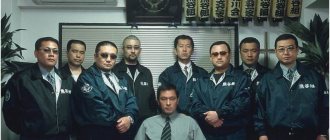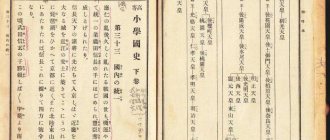Origin and history
Gaikokujin
or
gaijin
are relatively new words in the Japanese language.
The Portuguese, the first Europeans to visit Japan, were called nambanjin
(南蛮人 - "southern barbarians") because their ships came from the south and their sailors were considered rude and discourteous.
When English and Dutch adventurers reached Japan 50 years later, at the beginning of the 17th century, they began to be called komōjin
(紅毛人 - “red-haired people”).
When the Tokugawa regime was forced to open Japan to the outside world, Westerners were generally called ijin
(異人 - “another person”).
It is a shortened form of ikokujin
(異国人 - "person from another country") or
ihojin
(異邦人 - "person from another homeland"). These words were previously used for Japanese from another feudal area.
After the Meiji Restoration, the government coined the word gaikokujin
, which gradually replaced the words
ijin
,
ikokujin
and
ihojin
.
When the Empire of Japan conquered Korea and Taiwan, the word naikokujin
(内国人, “inland person”) was used to refer to the population of the imperial territories.
After World War II, this term lost its meaning, gaikokujin
became the official term for referring to non-Japanese, and all other terms fell out of use.
Modern use (in the 21st century)
In Japanese, shortened versions of long words are often used in common parlance. However, when the shortened form becomes popular and the colloquial meaning becomes generally accepted, the original form of the word may practically disappear from use.
The most formal term is gaikoku no kata
(外国の方 - roughly "person from another country"), followed by
gaikokujin
, and then
gaijin
.
The choice of wording has its own nuances. Thus, the word gaijin
is included in the list of words not recommended for use on television and radio.
People of Japanese descent living or born in other countries are called Nikkei-jin
, and children from mixed marriages are called
hafu
(from the English half half).
The word gaijin
can be used as an address.
In such a case, it is usually used with the nominal suffix -san
.
Sometimes the Japanese call foreigners this way, even when they themselves are abroad.
Source
Notes
Wikimedia Foundation. 2010.
See what “Gaijin” is in other dictionaries:
- Noun, number of synonyms: 1 foreigner (23) Dictionary of synonyms ASIS. V.N. Trishin. 2013 ... Dictionary of synonyms
baka-gaijin
- Japanese American ... Universal additional practical explanatory dictionary by I. Mostitsky
It is proposed to rename this page to Gaijin. Explanation of the reasons and discussion on the Wikipedia page: To rename / March 8, 2012. Perhaps its current name does not correspond to the norms of the modern Russian language and/or rules... ... Wikipedia
Japanese writing Kanji ... Wikipedia
Russians use non-Rus as a collective term, foreigners, inozemtsy, ino(alien) strangers. In Dahl's dictionary (1866) it is interpreted as “foreigners, aliens, foreigners” (inaccessible link). In Efremova’s explanatory word-formation dictionary... ... Wikipedia
Farang statue at Wat Pho, Bangkok Farang (Thai: ฝรั่ง, transcription: farang, Lao: phalang) is a word used by Thais to refer to Europeans. A word... Wikipedia
James Clavell James Clavell Birth Name: Charles Edmund Dumaresque Clavell Date of Birth: October 10, 1924 Place of Birth: Sydney, Australia ... Wikipedia
Material from Wikipedia - the free encyclopedia
Gaijin
(Japanese 外人) - an abbreviation of the Japanese word
gaikokujin
(Japanese 外国人), meaning “foreigner”.
The characters that make up the word gaikokujin
(外国人), means 外 "outside", 国 "country" and 人 "person".
Thus, the word literally means "a person from an outside country." In common parlance, a rough abbreviated form of gaijin
(Japanese 外人) can be used, which is a sabetsuyogo
(discriminatory word)
, containing only the characters 外 “outside” and 人 “person”; thus the word means "a person from outside."
Foreigner in Japanese is gaijin.
Foreigner in Japanese is gaijin. Formally, in documents, this word is used to refer to all foreigners living in Japan. However, no Japanese would ever call, for example, another Asian from Korea or China a gaijin in everyday speech. There are separate words for them, but the word gaijin does not fit here. Neighbors are not strangers enough. After all, in fact, this word completely sounds like “ gai-koku-jin ” - which literally means “another-country-person”, but the Japanese are in a hurry and usually skip the word country, so it turns out “ gai-jin” - another person, a stranger. Not very polite, but short and succinct.
Meet the gaijin
A short course in gaijin studies by Dr. Carlson, patent pending. Translation from Russian into Japanese and back.
Have you been interested in gaijin since childhood? They're so funny, aren't they? But was it scary to approach them or talk to them? Were you shy? Do not be afraid - Dr. Carlson is already hastening to your aid with his epic work - a course of gaijin studies that will help you get rid of unnecessary fears and teach you fun games and techniques that will be useful to you in order to establish contact with any, even the wildest, gaijin.
1. Basic facts about gaijin. All gaijins look alike, behave very similarly and speak English. Therefore, there is absolutely nothing stopping us from generalizing them to one type when studying. It’s easier for you to assume that they are all Americans, and the gaijin will only be pleased, because, as is well known, even those gaijin who pretend not to be Americans secretly dream of becoming one.
All gaijin are absolutely stupid. Remember, your three-month-old puppy thinks faster and knows more about life than any gaijin . Therefore, you need to speak to a gaijin slowly and confidently. Then he'll probably understand something, even if you speak Japanese and gaijin doesn't.
Gaijins cannot read or write. And talk. If a gaijin can read and write, then it is most likely an incorrect gaijin . Most likely this is a spy (remember Sorge!). Communication with such a gaijin should be avoided. All gaijin speak excellent English, however, they understand extremely poorly when addressed in English. However, any gaijin you see on the street can be a good reason to practice your English.
2. What to do when meeting a gaijin? If you meet a gaijin on the street... Go up to him and say hello in clear English. Wait a few minutes until the gaijin understands what language you used to greet him. If you are homeless, then you can also salute every gaijin passing by and shout “America - Number One!” Don't forget to tell everyone around you that you have seen a gaijin. And if you saw several gaijin at once, you should even call your friends on your cell phone and tell them about it too. Joy must be shared. Teach your children a fun and useful game to practice English. When you see a gaijin on the street, your child should shout out loud: “Look, everyone, a living gaijin!” Well-mannered children are also allowed to shout gaikokujin instead of gaijin . After this, your child quickly runs up (rides up on a bicycle) to the gaijin and shouts “Hello” to him right in his ear and just as quickly runs (rides away) back. There is nothing more fun than looking at a surprised gaijin, who at this moment is still figuring out how to respond to the heels or wheels running away from him. When talking to a gaijin... If a gaijin tells you “Konnichiwa!” - so much so that it’s immediately clear that he can’t say anything more, then be sure to tell him that he already speaks Japanese very skillfully. It will be incredibly funny to watch a confused gaijin try to answer you that no, he doesn’t know anything other than this word. Do not give up. Try to convince him that even this one word is enough for him to speak Japanese very skillfully. Remember! In no case can one say that they speak Japanese very skillfully to those gaijins who actually know more than 10 words. This is the wrong kind of gaijin and should not be encouraged. It is also permissible to tell the gaijin that you have been studying English for 3 years, that it is now terribly cold (hot) outside, ask where the gaijin came from, or even tell him that it is high time for him to go back to his America. Just before this, you should not forget to ask the gaijin to take a photo with you, otherwise you never know. If you meet a gaijin in a restaurant... This is your chance. Tell the gaijin that he is extremely skilled with chopsticks. Then offer to teach him how to use them, as they SHOULD be. Feel free to photograph the gaijin while he is eating. Gaijin will be pleased with your attention, and you will get a few minutes of healthy laughter with friends and the opportunity to use these photographs for educational purposes, to later show your three-year-old child how NOT to eat with chopsticks. If you meet a gaijin at a hot spring... Feel free to look at him from head to toe and from all sides. Check to see if the gaijin has a tail. Some entomologists say this happens too, so it's best to be on the lookout! Also tell the gaijin that the hot springs in your home village are much better, but, in truth, you have not been to them for 10 years since you moved to live in Tokyo. When naked, gaijin are not particularly shy and greet communication with joyful splashes of water. If you meet a gaijin on the subway... Never sit next to a gaijin. It is correct to sit opposite. This will help you get a better look at the gaijin from a safe distance. Don’t be shy about looking at a gaijin closely and directly in the eyes—gaijin love attention. At this point, the short course of study (that’s why it’s short) can be considered complete. Don't be afraid to experiment. Gaijin on the streets of Japanese cities are waiting for you! Let's finish the course with a little testing. Test yourself!
1.) Gaijin eat: a. Bread b. Bread in. Other 2.) Gaijin speak: a. English b. English in. English and a little more 3.) Among the three Japanese seasons, gaijins are loved the most: a. Earthquake season b. Typhoon season in. Rain season
Write down your answers. After reading this book, answer the questions again and compare your answers with those written down. This will allow you to learn something unexpected about you. If your new answers never coincide with those written down, then you are easily suggestible and completely in vain to believe the author of the book. If your answers sometimes matched those written down and sometimes did not, then you have a bad memory. If your answers always coincide with those written down, then you are the author of this book and it’s time for you to finally stop re-reading the manuscript and should have sent the result to the publishing house long ago.
Source
Japanese nominal suffixes (or how they address each other in Japan)
Some time ago I was asked to write a large detailed text about the Japanese honorific, however, keeping in mind the idea of not causing harm to living beings, I decided to make a short note in a positive way, simply helping not to make obvious mistakes when communicating. So. The Japanese language has what is called “polite speech” (keigo), one part of which is a class of special nominal suffixes added to given names and surnames, and sometimes to professions. These suffixes play an important role in Japanese life, and misusing them can lead to misunderstanding and often offense. Therefore, for the sake of brevity, let's immediately accept two main postulates: 1. These suffixes are used by the Japanese in Japanese life, with their help the Japanese demonstrate in speech and writing the degree of politeness, deference, intimacy and hierarchical subordination. 2. Incorrect use of these suffixes by a non-Japanese when communicating with Japanese can either lead to an insult to the Japanese, or to the perception of you as completely ignorant of local customs (which, however, should be the default, but you should not constantly confirm this with your actions).
We are not Japanese, most of us do not live permanently in Japan, some may never get to this country. However, such a possibility exists. And at the moment when it can suddenly manifest itself, it is advisable not to spoil everything by fundamentally ignoring local customs. There are a great many such customs, no one forces you to know them all, but it is advisable to know the most common and obvious ones (such as “101 rules for using chopsticks”, “How to eat sushi correctly”).
So we just remember.
— A Japanese person can address you as “Izya-san”, this is the usual polite neutral address (if he addresses you as “Izya-kun”, then perhaps this is a hint of a trusting relationship, or maybe the boss just decided to give you instructions to run for papers on the 50th floor of the office; there is another reason for such a request, in which case it is better to read this post in 10 years, not earlier). - You should address Japanese as "Suzuki-san", omitting this suffix (and any suffix) is a direct insult, which is hardly mitigated by your origin. — When talking to a Japanese person about any third person, you must use the appropriate suffix (“I learned this from Mononoke-san”). — You can address another foreigner as “Vasya-san” in Japan in the presence of Japanese people, but this is not a mandatory requirement, but only a tribute to politeness in the general context of the conversation. — You can address someone “Kolya-san” outside of Japan and the Japanese, however, for the sake of sobriety, you should remember that from the outside it looks funny (well, unless it was intended to be funny in the first place); you might as well address him as “Kolya-dzhan.” Here I would like to add that the address "-san" is possible, for example, in a Japanese language lesson or in a Japanese arts and crafts training; however, it’s always funny to see this somewhere on Facebook or VKontakte. — The Japanese say “Yobanashi-sensei” when talking about: a) a doctor b) any teacher, teacher at school, university, etc. c) a scientist (with a degree) d) a very respected and famous master of something e) politics j) as a personal relationship with a person who teaches him something or taught him something important. — A Japanese person will never say “Sensei Kuniguchi” because “Sensei” is a suffix, not a prefix. — “Sensei” can also be used as a standalone word when a Japanese person is directly addressing someone or when it is contextually clear which sensei is being referred to in the third person. — A Japanese person will never say about himself “I am sensei” or “Hello, my name is Fuyashi-sensei” because this is extremely arrogant and impolite; for the same reason, the Japanese also do not apply the suffix “-san” to themselves. — That’s why a Japanese will never write “sensei” on his business card as a profession or status in a group; for this, there are words meaning professions, positions and titles (“sensei” is not a profession, position or title! And even, oh horror, not a master's degree in martial arts). “And that’s why he will never sign a photo about himself in the third person, where he is depicted with his colleague, “Sensei Abe and Sensei Wege visiting Akasata Sensei.”
And you shouldn't do that either.
Also, lovers of all kinds of martial and not so arts and crafts should not forget that, as a rule, in a conversation with the Japanese, the oldest teacher is usually called “sensei” (although there are cases when in a conversation with a sensei we are actually talking about another sensei). For example, for you personally Mr. Akasata is a teacher, but for Mr. Mayarava he is just an acquaintance or even a student. Therefore, Mayarava-sensei (or Mayarava-san), when you say “Akasata-sensei” in a conversation with him, will most likely very politely and quietly put you in your place by asking again “Akasata-san?”, or he will simply say in conversation only "Aksakata-san". The Japanese are very patient and understanding people.
There are a dozen more similar suffixes, most of which you will never use at all, and the rest you will use confidently when you live in Japan for many years. Therefore, treat all kinds of “senpai” and “kohai” outside Japanese life with humor and irony. Well, if, of course, you really want to bend over backwards, you can add “senpai” when addressing a student of a higher rank, just don’t overdo it.










